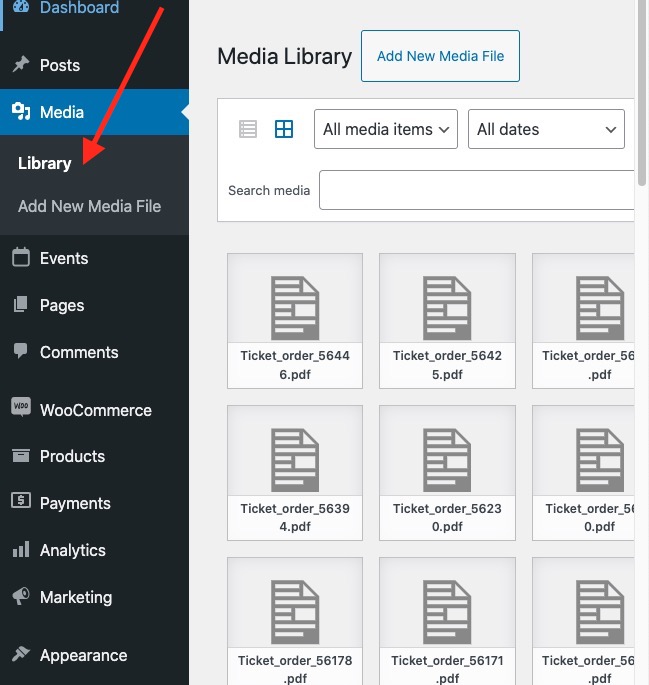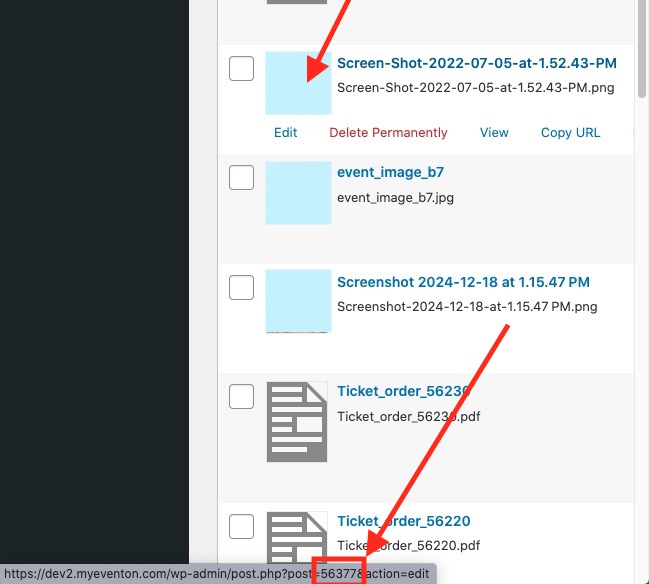- Get Started
- User Guide
- How to
- ** How to use event_type category to do more
- How to Activate EventON
- How To Allow Users to Submit Events and Create an Events Listing Page
- How to apply a patch fix
- How to Bulk Update Language Translations Using the Import/Export Tool
- How to cancel addon subscription before auto renew
- How to Deactivate EventON Addon Licenses
- How To Display or Hide the Live Now Icon
- How to Enable Auto-updates for EventON
- How to find your EventON license key
- How to Fix a Broken Sidebar Caused by the EventON Widget
- How To Hide Blank Rows On the Calendar EventTop
- How To Set Up and Use the Filter Bar on Calendars
- How to Set Up Health Guidelines for EventON and Extend It
- How to Setup & Use Custom Fields for Events
- How to setup & use multi data types
- How to Setup Basic Paypal for Events
- How to show past events
- How to show your calendar on external sites using an iFrame
- How To Turn on Sort Options On Your Calendar
- How To Upgrade Your EventON Addon License
- How to Use Hashtags to Link to Event Sections
- How to Use Single Event Data Values
- How to Use the EventCard Designer
- How To Use the EventON Shortcode Executor(ESE) Widget
- How To Use The EventTop Designer
- How To Use the ICS Import Tool
- How to Use Virtual Visible Event End Time for Events with Limited Visibility but Extended Durations
- Using an SMTP Mail Plugin To Solve Email Delivery Issues in EventON
- General
- Basic System Requirements for EventON
- Best Practices Before Doing an Addon Update
- How to Delete Old Events from WordPress Trash Automatically
- How To Upgrade From Lite to Full Version
- I am confused about Event Type categories
- What is the calendar filter
- Why am I unable to proceed with the checkout for addon purchases?
- Troubleshooting
- ** What to check if eventON is not working
- How to debug for PHP code errors
- How to debug Javascript interactive issues
- How to find if an issue is coming from eventON
- How to fix font awesome icons not working on your site
- How to fix style override issues
- Increasing the WordPress Memory Limit
- Troubleshooting Using the Health Check Plugin
- Why is Location Google Map grayed out or not displayed on Event Card
- Virtual Events
- Frequently Asked Questions
- Code snippets
- CODE: To add additional healthcare guidelines
- How to add new social share icons
- How to change “events” slug & rewrites
- How to customize the eventtop date format
- How to hook into eventTop
- How to increase event type category count
- How to load EventON scripts to a page
- How to show additional custom data in the eventCard
- CODEX
- Other
- Tricks and Tips
- ** Override CSS in your calendar
- How to create events that goes past midnight
- How to customize Events archive page
- How to customize location and organizer archive page
- How to override event colors with event type colors
- How to show featured image on eventTop
- How to show various information on the eventTop
- How to translate EventON with WPML on the front-end
- One solution for /events slug not working
- Various Creative Ways to Use Multi Data Types
- APIs
- Addons
- Action User
- ActionUser Paid Feature Events
- ActionUser Plus
- Advent Calendar
- Bookings
- Countdown
- CSV Importer
- DailyView
- Dynamic Pricing
- Event API
- Event Dynamic Pricing
- Event Lists
- Event Map
- Event Photos
- Event Reviewer
- Event Search
- Event Seats
- Event Slider
- Event Tickets
- Auto Complete Ticket Order
- Auto re-stocking refunded, cancelled or failed orders
- Changelog for Event Tickets
- CODE: How to send Emails as Bcc
- How to add additional data to confirmation email
- How to add additional fields at checkout
- How to add additional fields to download attendees CSV file
- How to customize ticket email template
- How to manage capacity separately for repeat events
- How to set up Event Tickets
- How to set up variable prices for Tickets
- How To Switch From WooCommerce Blocks to Shortcode-Based Cart & Checkout Pages
- Event Wishlist
- Filters Plus
- FullCal
- ICS Importer
- Include Anything
- Lists & Items
- Moon Data
- PDFer
- Polls
- QR Code
- Reminders
- Repeat Customizer
- RSS Feed
- RSVP Events
- RSVP Events Invitees
- RSVP Events Waitlist
- RSVP Points
- Single Events
- Speakers & Schedule
- Subscriber
- Sync Events
- Tickets Waitlist
- Variations & Options
- Virtual Plus
- Weather
- WeeklyView
- YearlyView
- Policies
- Server Related
- Shortcode
- Translation & Languages
How To Stop Duplicating Images In CSV Imports
Last Updated: January 22, 2025
Migrating events from one site to another or from one calendar to your EventON calendar should be hassle-free. In order to start importing events, you will need to have at least EventON 2.6 and the CSV Event Importer addon installed.
In this tutorial, we are going to be going through some steps that you can take to prevent duplicate images in your media gallery after a successful event import.
Formatting your CSV file
We recommend starting off the import process by copying and modifying the sample.csv file that comes with the addon after purchase. By default, the addon accepts the following CSV columns that should be used as headers on your CSV file:
- publish_status – Publish status of the event: publish | draft
- event_id (int) – Event post ID, if passed, event with this id will be updated with meta data
- featured – Feature an event or no eg yes | no
- color – Hex color for the event without # sign
- event_name – Name of the event
- event_description – Event main description
- event_start_date & event_end_date – Start/End date in format mm/dd/YYYY
- event_start_time & event_end_time – Start/End time in format h:mm:AM/PM
- Location Fields:
- location_name => Event location Name
- event_location => Event location complete address
- evcal_location_link => Location Link (http://)
- evo_location_id => Location taxonomy term ID
- Organizer Fields:
- event_organizer => Organizer Name
- evcal_org_contact => Organizer contact information eg. email
- evcal_org_address => Organizer location address
- evcal_org_exlink => Organizer external link (http://)
- evo_organizer_id => Organizer taxonomy term ID
- event_gmap – Generate google maps from address. eg yes | no
- evcal_subtitle – Event Subtitle
- all_day – All day event eg. yes | no
- hide end time -Hide end time for event eg. yes | no
- event_type categories – Event type category term IDs separated by commas eg. 4,19. You can add up to 5 event type categories in separate columns with column headers in format event_type, event_type_2, etc.
- Custom Meta Fields:
- cmd_{x} => Custom meta data values. You can add upto 10 custom meta field values with sepeate columns with column headers in format cmd_{x}
- cmd_{x}L => can be used for custom field button url data
- image_url – Complete http:// url to an image from external source
- image_id – (integer) existing attachment ID from wordpress site you are importing events to
- evcal_lmlink – Learn more link (http)
- evcal_lmlink_target – Learn more link open in new window yes | no
- User Interaction Fields:
- _evcal_exlink_option => UX_val from 1-4 (integer)
- evcal_exlink => UX_VAL link to event URL (http://)
- _evcal_exlink_target => UX_val link open in new window yes | no
- ActionUser Compatible Fields:
- evoau_assignu => User IDs seperated by comma to assign users to events
If the event images already exist in your media gallery, you should exclude the image_url column in your CSV file. This option downloads the image from the provided link and imports it to your media gallery hence causing multiple occurrences of the same images.
You should ONLY make use of the image_id column in your CSV file and populate this with the attachment ids of the images that exist on your media gallery.
How to get the attachment ID
- Head over to your media library by clicking on Media > Library.

2. Switch to the List view.

3. Hover / Mouse over the image that you would like to import and check the number that is displayed at the bottom left of the page.

You can use 30592 as the image_id in your import file and this will ensure that there are no duplicates after the import.
For additional import troubleshooting tips, please go through the following guide: How to Troubleshoot CSV Import Issues.
Did this article help you?